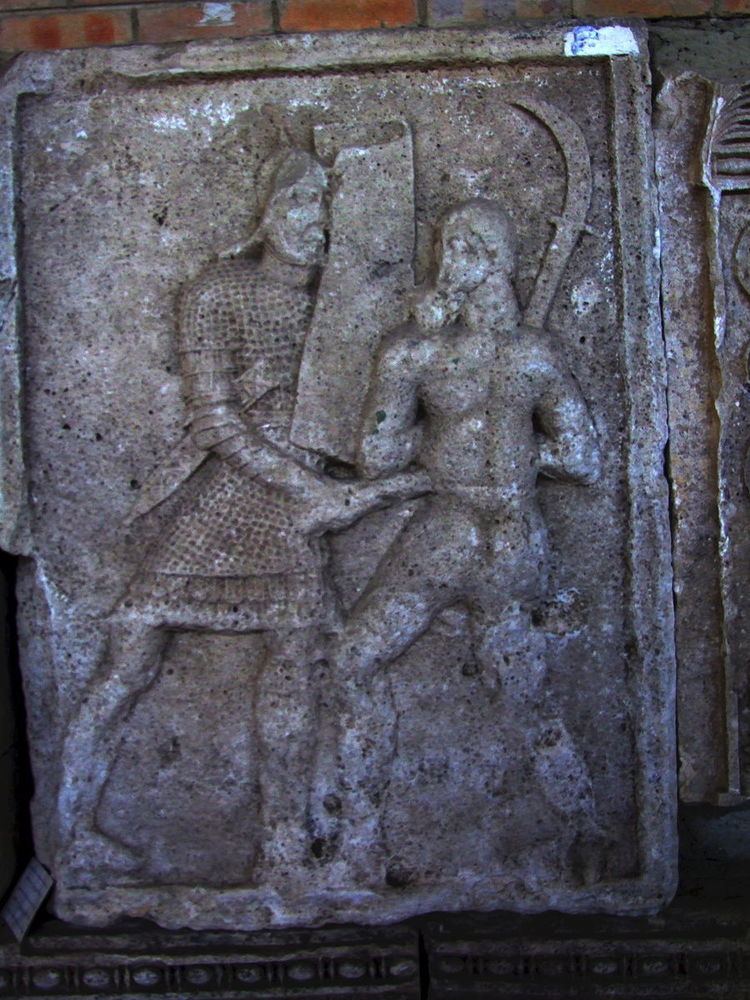 | ||
The history of Dacian warfare spans from c. 10th century BC up to the 2nd century AD in the region defined by Ancient Greek and Latin historians as Dacia. It concerns the armed conflicts of the Dacian tribes and their kingdoms in the Balkans. Apart from conflicts between Dacians and neighboring nations and tribes, numerous wars were recorded among Dacians too.
Contents
Tribal wars
The Dacians fought amongst each other but were later united first under Burebista and later under Decebalus. Despite this after the death of Burebista at 44 BC they had been split by a civil war.
Domitian's Dacian War
The two punitive expeditions mounted as a border defense against raids of Moesia from Dacia in 86-87 AD ordered by the Emperor Titus Flavius Domitianus (Domitian) in 87 AD, and 88 AD. The first expedition was an unmitigated disaster, and the second achieved a peace, seen as unfavorable and shameful by many in Rome.
Trajan's Dacian Wars
Trajan's Dacian Wars. The two campaigns of conquest ordered or led by the Emperor Trajan in 101-102 AD, and 105-106 AD from Moesia across the Danube north into Dacia. Trajan's forces were successful in both cases, reducing Dacia to client state status in the first, and taking the territory over in the second. These wars involved no less than 13 legions.
Infantry and cavalry
The Dacian tribes were part of the greater Thracian family of peoples. They established a highly militarized society and, during the periods when the tribes were united under one king (82 -44 BC, 86-106 AD), posed a major threat to the Roman provinces of Lower Danube. Dacia was conquered (except for the Free Dacians) and transformed into a Roman province in 106 after a long, hard war.
The most important weapon of the Dacian arsenal was the falx. This dreaded weapon, similar to a large sickle, came in two variants: a shorter, one-handed falx called a sica, and a longer two-handed version. The shorter falx was called sica (sickle) in the Dacian language. The two-handed falx was a polearm. It consisted of a three-feet long wooden shaft with a long curved iron blade of nearly-equal length attached to the end. The blade was sharpened only on the inside, and was reputed to be devastatingly effective. However, it left its user vulnerable because, using a two-handed weapon, the warrior could not also make use of a shield. Alternatively, it might be used as a hook, pulling away shields and cutting at vulnerable limbs.
Using the falx, the Dacian warriors were able to counter the power of the compact, massed Roman formations. During the time of the Roman conquest of Dacia (101 - 102, 105 - 106), legionaries had reinforcing iron straps applied to their helmets. The Romans also introduced the use of leg and arm protectors (greaves and manica) as further protection against the falxes.
The Dacians were adept of surprise attacks and skilful, tactical withdrawals using the fortification system. During the wars with the Romans, fought by their last king Decebalus (87-106), the Dacians almost crushed the Roman garrisons south of the Danube in a surprise attack launched over the frozen river ( winter of 101-102 ). Only the intervention of Emperor Trajan with the main army saved the Romans from a major defeat. But, by 106, the Dacians were surrounded in their capital Sarmizegetusa. The city was taken after the Romans discovered and destroyed the capital's water supply line.
Dacians decorated their bodies with tattoos like the Illyrians and the Thracians. The Pannonians north of the Drava had accepted Roman rule out of fear of the Dacians.
Dacia remained a Roman province until 271.
Marcus Annaeus Lucanus 39 - 65 wrote of Dacian hordes;
Have poured her captains, and the troops who guard the northern frontier from the Dacian hordes
Dacians that could afford armor wore customised Phrygian type helmets with solid crests (intricately decorated), domed helmets and Sarmatian helmets. They fought with spears, javelins, falxes, one-sided battle axes and used "Draco" Carnyxes as standards. Most used only shields as a form of defense. Cavalry would be armed with a spear, a long La Tène sword and an oval shield.
Most of the infantry would wield a falx and perhaps a sica and would wear no armor at all even shunning shields.
Mercenaries
Dacian mercenaries were uncommon in contrast to the Thracians and the Illyrians but they could be found in the service of the Greek Diadochi and of the Romans.
Nobility
A 2nd century chieftain would wear a bronze Phrygian type helmet,a corselet of iron scale armor,an oval wooden shield with motifs and wield a sword.
Navy
There was no Dacian navy except perhaps boats to cross the Danube.
Fortifications
Dacians had built fortresses all around Dacia with most of them being on the Danube. A scene from Trajan's column shows Romans attacking a Dacian fortification using the "testudo".
The Dacians constructed stone strongholds, davas, in the Carpathian Mountains in order to protect their capital Sarmizegetusa. The fortifications were built on a system of circular belts. This allowed the defenders, after a stronghold was lost, to retreat to the next one using hidden escape gates.
Barbarians
Dacians were shown by Trajan as dignified and heroic but still dangerous and unable to stand against the might of Rome. 1st century BC poet Horace writes of them in one of his works and mentions them along with the Scythians as tyrants and fierce barbarians. Later historian Tacitus writes that they are a people that can never be trusted
The Ancient Greeks expressed admiration and respect for Burebista.
List of Dacian battles
This is a list of battles or conflicts that Dacians had a leading or crucial role in, rarely as mercenaries. They were involved in massive battles against Roman legions.
